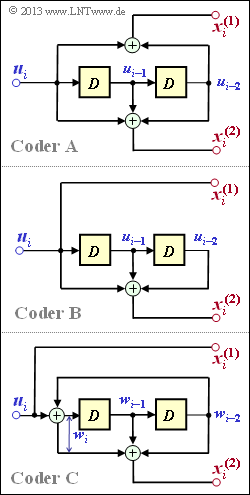Difference between revisions of "Aufgaben:Exercise 3.4: Systematic Convolution Codes"
| Line 24: | Line 24: | ||
''Hinweise:'' | ''Hinweise:'' | ||
* Die Aufgabe gehört zum Kapitel [[Kanalcodierung/Algebraische_und_polynomische_Beschreibung| Algebraische und polynomische Beschreibung]]. | * Die Aufgabe gehört zum Kapitel [[Kanalcodierung/Algebraische_und_polynomische_Beschreibung| Algebraische und polynomische Beschreibung]]. | ||
| + | * Bezug genommen wird insbesondere auf die Seiten [[Kanalcodierung/Algebraische_und_polynomische_Beschreibung#.C3.9Cbertragungsfunktionsmatrix_.E2.80.93_Transfer_Function_Matrix|Übertragungsfunktionsmatrix – Transfer Function Matrix]] sowie [[Kanalcodierung/Algebraische_und_polynomische_Beschreibung#.C3.84quivalenter_systematischer_Faltungscode|Äquivalenter systematischer Faltungscode]]. | ||
| Line 41: | Line 42: | ||
+ $\mathbf{G}_{\rm sys}(D) = (1, \ (1 + D + D^2)/(1 + D^2))$. | + $\mathbf{G}_{\rm sys}(D) = (1, \ (1 + D + D^2)/(1 + D^2))$. | ||
| − | {Welcher Coder ist zu Coder A äquivalent und systematisch? | + | {Welcher Coder ist zu '''Coder A''' äquivalent und systematisch? |
|type="[]"} | |type="[]"} | ||
- <b>Coder B</b>, | - <b>Coder B</b>, | ||
Revision as of 16:44, 20 January 2018
Man spricht von einem systematischen Faltungscode der Rate $R = 1/2$ ⇒ $k = 1, \ n = 2$, wenn das Codebit $x_i^{(1)}$ gleich dem momentan anliegenden Informationsbit $u_i$ ist.
Die Übertragungsfunktionsmatrix eines solchen Codes lautet:
- $${\boldsymbol{\rm G}}(D) = \big ( \hspace{0.05cm} 1\hspace{0.05cm} , \hspace{0.2cm} G^{(2)}(D) \hspace{0.05cm}\big ) \hspace{0.05cm}.$$
Der in der oberen Grafik dargestellte Coder A ist sicher nicht systematisch, da für diesen $G^{(1)}(D) ≠ 1$ gilt. Zur Herleitung der Matrix $\mathbf{G}(D)$ verweisen wir auf ein früheres Beispiel, in dem für unseren Standard–Rate–1/2–Coder mit Gedächtnis $m = 2$ die Übertragungsfunktionsmatrix ermittelt wurde:
- $${\boldsymbol{\rm G}}(D) \hspace{-0.15cm} \ = \ \hspace{-0.15cm} \big ( \hspace{0.05cm} G^{(1)}(D)\hspace{0.05cm} , \hspace{0.2cm} G^{(2)}(D) \hspace{0.05cm}\big ) = \big ( \hspace{0.05cm} 1 + D + D^2\hspace{0.05cm} , \hspace{0.2cm} 1 + D^2 \hspace{0.05cm}\big ) \hspace{0.05cm}.$$
Der Coder A unterscheidet sich gegenüber diesem Beispiel nur durch Vertauschen der beiden Ausgänge. Lautet die Übertragungsfunktionsmatrix eines Codes
- $${\boldsymbol{\rm G}}(D) = \big ( \hspace{0.05cm} G^{(1)}(D)\hspace{0.05cm} , \hspace{0.2cm} G^{(2)}(D) \hspace{0.05cm}\big ) \hspace{0.05cm},$$
so gilt für die äquivalente systematische Repräsentation dieses Rate–1/2–Faltungscodes allgemein:
- $${\boldsymbol{\rm G}}_{\rm sys}(D) = \big ( \hspace{0.05cm} 1\hspace{0.05cm} , \hspace{0.2cm} {G^{(2)}(D)}/{G^{(1)}(D)} \hspace{0.05cm}\big ) \hspace{0.05cm}.$$
In der Teilaufgabe (3) ist zu prüfen, welcher der systematischen Anordnungen (entweder Code B oder Code C oder auch beide) äquivalent zum Code A ist.
Hinweise:
- Die Aufgabe gehört zum Kapitel Algebraische und polynomische Beschreibung.
- Bezug genommen wird insbesondere auf die Seiten Übertragungsfunktionsmatrix – Transfer Function Matrix sowie Äquivalenter systematischer Faltungscode.
Fragebogen
Musterlösung
Der Vorschlag 3 gilt für einen systematischen Code ⇒ $\underline{x}^{(1)} = \underline{u}$. Der hier betrachtete Coder A weist diese Eigenschaft allerdings nicht auf.
(2) Um von einem nichtsystematischen $(n, \ k)$–Code mit Matrix $\mathbf{G}(D)$ zum äquivalenten systematischen Code ⇒ Matrix $\mathbf{G}_{\rm sys}(D)$ zu gelangen, muss man allgemein $\mathbf{G}(D)$ aufspalten in eine $k × k$–Matrix $\mathbf{T}(D)$ und eine Restmatrix $\mathbf{Q}(D)$. Das gewünschte Ergebnis lautet dann mit der $k × k$–Einheitsmatrix $\mathbf{I}_k$:
- $${\boldsymbol{\rm G}}_{\rm sys}(D) = \big ( \hspace{0.05cm} {\boldsymbol{\rm I}}_k\hspace{0.05cm} ; \hspace{0.1cm} {\boldsymbol{\rm T}}^{-1}(D) \cdot {\boldsymbol{\rm Q}}(D)\hspace{0.05cm}\big ) \hspace{0.05cm}.$$
Wir gehen hier von der $\mathbf{G}(D)$–Matrix für den Coder A aus. Wegen $k = 1$ haben hier sowohl $\mathbf{T}(D)$ als auch $\mathbf{Q}(D)$ die Dimension $1 × 1$, sind also streng genommen gar keine Matrizen:
- $${\boldsymbol{\rm G}}(D) = \big ( \hspace{0.05cm} {\boldsymbol{\rm T}}(D)\hspace{0.05cm} ; \hspace{0.2cm} {\boldsymbol{\rm Q}}(D)\hspace{0.05cm}\big ) \hspace{0.3cm} \Rightarrow \hspace{0.3cm}{\boldsymbol{\rm T}}(D) = \big ( 1+D^2\big )\hspace{0.05cm} , \hspace{0.2cm} {\boldsymbol{\rm Q}}(D) = \big ( 1+D+D^2\big )\hspace{0.05cm} .$$
Für die beiden Elemente der systematischen Übertragungsfunktionsmatrix erhält man:
- $$G^{(1)}(D) \hspace{-0.15cm} \ = \ \hspace{-0.15cm} {\boldsymbol{\rm T}}(D) \cdot {\boldsymbol{\rm T}}^{-1}(D) = 1 \hspace{0.05cm},$$
- $$G^{(2)}(D) \hspace{-0.15cm} \ = \ \hspace{-0.15cm} {\boldsymbol{\rm Q}}(D) \cdot {\boldsymbol{\rm T}}^{-1}(D) = \frac{1+D+D^2}{1+D^2}$$
- $$\Rightarrow \hspace{0.3cm}{\boldsymbol{\rm G}}_{\rm sys}(D) = \big ( \hspace{0.05cm} 1\hspace{0.05cm} , \hspace{0.1cm} \frac{1+D+D^2}{1+D^2} \hspace{0.05cm}\big ) \hspace{0.05cm}.$$
Richtig ist also der letzte Lösungsvorschlag. Der Lösungsvorschlag 1 beschreibt keinen systematischen Code. Ein Code entsprechend Lösungsvorschlag 2 ist zwar systematisch, aber nicht äquivalent zum Code A entsprechend der vorgegebenen Schaltung und Übertragungsfunktionsmatrix $\mathbf{G}(D)$.
(3) Die Generatorfunktionsmatrix von Coder B lautet:
- $${\boldsymbol{\rm G}}_{\rm B}(D) = \big ( \hspace{0.05cm} 1\hspace{0.05cm} , \hspace{0.2cm} {1+D+D^2} \hspace{0.05cm}\big ) \hspace{0.05cm}.$$
Dieser Coder ist also nicht äquivalent zum Coder A. Betrachten wir nun den Coder C. Hier gilt für das zweite Matrixelement von $\mathbf{G}(D)$:
- $$w_i \hspace{-0.15cm} \ = \ \hspace{-0.15cm} u_i + w_{i-2} \hspace{0.25cm} \circ\!\!-\!\!\!-^{\hspace{-0.25cm}D}\!\!\!-\!\!\bullet\hspace{0.25cm} {U}(D) = W(D) \cdot (1 + D^2 ) \hspace{0.05cm},$$
- $$x_i^{(2)} \hspace{-0.15cm} \ = \ \hspace{-0.15cm} w_i + w_{i-1} + w_{i-2} \hspace{0.25cm} \circ\!\!-\!\!\!-^{\hspace{-0.25cm}D}\!\!\!-\!\!\bullet\hspace{0.25cm} {X}^{(2)}(D) = W(D) \cdot (1 +D + D^2 )$$
- $$\Rightarrow \hspace{0.3cm} G^{(2)}(D) = \frac{{X}^{(2)}(D)}{{U}(D)} = \frac{1+D+D^2}{1+D^2}\hspace{0.05cm}.$$
Dies entspricht genau dem Ergebnis der Teilaufgabe (2) ⇒ Lösungsvorschlag 2.
